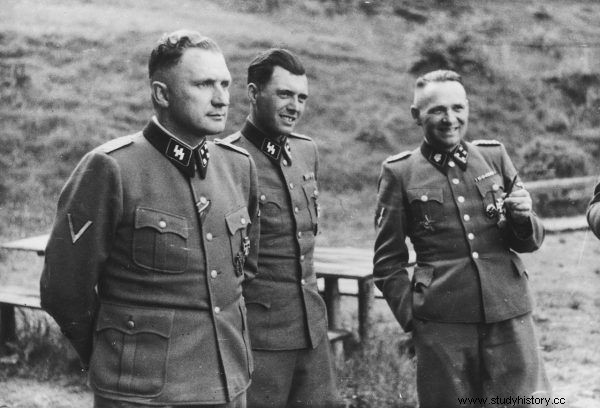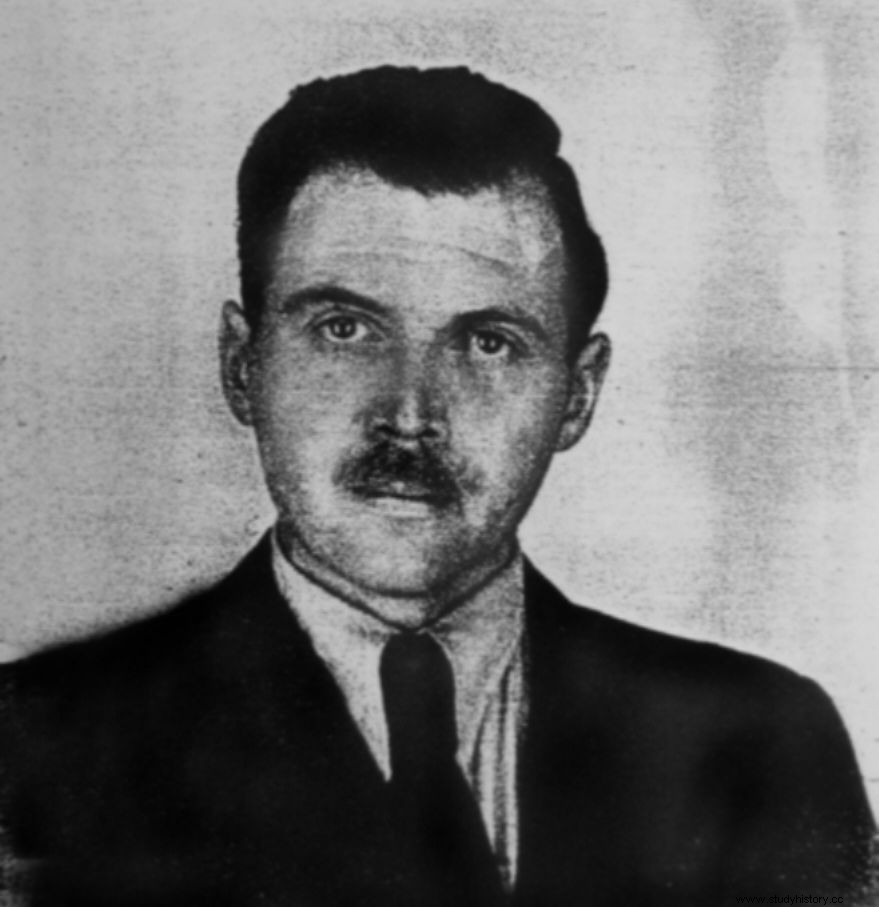A few months after leaving Auschwitz, Josef Mengele, fleeing west, joined a motorized field hospital. The unit hid in the no-man's zone, between the allied armies. Eventually the Americans intercepted her ... but soon the Angel of Death was at liberty again. How is that possible?
Somehow Mengele [who had previously exchanged his SS officer uniform for a Wehrmacht uniform] managed to avoid detection for six weeks, during which his hospital was stuck in the woods. On June 15 [1945] American units entered the hospital grounds, capturing about 10,000 German soldiers. However, Mengele was not among them, and he and his squad tried to escape. In his autobiography he writes:
We were eating less and less; in addition, rumors were spread that our territory was to be occupied by the Russians. So we decided to act. Using a few available vehicles and a team of paramedics, we formed a column that, after clever maneuvers, managed to get through the lines of American troops. Avoiding road blocks, we finally reached Bavaria.
Under your own name
Mengele's freedom did not last long, however. Bavaria was crowded with American posts and after a few days his unit was captured:
We were detained near the first bigger town, Weiden, and transferred to an American POW camp. And so we were running out of gasoline. The Americans later moved us to another camp, where food rations were even smaller and our situation increasingly hopeless.

In June 1945, Mengele was sent to a POW camp. Illustrative photo.
In the first American camp, Mengele met Hans Kahler again, arrested on the same day (...). Dr. Kahler and Dr. Ulmann disagree about the surname under which Mengele was registered in the camp. Dr. Ulmann claims that he gave the Americans his real name. Dr. Kahler, on the other hand, believes that he originally registered as "Memling," but later, at the instigation of Kahler, who considered the use of the pseudonym dishonorable, changed his statement, reverting to his real name. Either way, it is known for certain that for some time Mengele was in the hands of Americans who knew his name .
None of the Americans knew, however, that Mengele was a member of the SS - this information would have been enough to subject Mengele to a thorough interrogation and verify that he was not on the list of Nazi war criminals. Mengele only saved his life through his own vanity:in 1938, when he joined the SS, he refused to have his blood type tattooed on his chest or arm.
He managed to convince the SS that a tattoo was unnecessary:he said that any competent surgeon would carry out appropriate tests anyway before making a transfusion. According to Irene, however, the real reason was Mengele's self-love. She claimed that her husband liked to stand in front of a large mirror sometimes, admiring the smoothness of his skin, which he did not want to taint with a tattoo.
The lack of a tattoo prevented the Americans from discovering that Mengele belonged to the SS. The Americans did require that each captured soldier fill out an appropriate questionnaire and present their pay book with information about the unit in which the soldier served; Mengele, however, lied on the questionnaire and no documents proving his connection to the SS were found on him .

The above text is an excerpt from the book by Gerald Posner and John Ware, "Mengele. Hunt for the Angel of Death from Auschwitz ”(Znak Horizon 2019).
Criminal lists
At the time, he hadn't even realized how lucky he was. In April 1945, two months before the Americans arrested him, Josef Mengele was placed on the list of major Nazi war criminals. Those who managed to survive his cruel experiments began to testify before the Polish, French, Yugoslav, British and Czechoslovak authorities. In May, "Dr. Joseph Mengele, Lagerarzt, Oswiecim KL" was already on the list of people wanted by the United Nations War Crimes Commission for "mass murder and other crimes".
His name was entered into the first Central Registry of War Criminals and Security Suspects (CROWCASS), distributed by the Supreme Allied Command in Paris to all POW camps. The U.S. also undertook the collection of evidence against him. Judge Advocate General Office.
Yet Mengele penetrated the American sieve. Several factors played a major role in his eventual escape:the lack of coordination between the various formations of the American occupation forces, the difficulty of finding war criminals among the millions of detained Germans, and finally his own vanity that made him refuse to get a tattoo.
Immediately after the end of the war, the Allied administration was in such chaos that some lists of war criminals did not end up in POW camps throughout the summer of 1945 . It is not known whether the letters from NZ or CROWCASS ever ended up in the hands of the commanders of the camp where Mengele was detained. The US Bureau of Special Investigations has not been able to find any such material, despite a very thorough investigation in 1985. If the camp authorities had the appropriate letters, then it should be assumed that they showed an inexplicable carelessness.

Mengele (standing in the center) entered the war criminals list as early as April 1945.
However, there is a high probability that the letters of the criminals never reached the camp. Mengele benefited from the US policy of cursory interrogation of prisoners, introduced due to the overcrowding of POW camps and the desire to release physically fit men as soon as possible, so that they could start rebuilding Germany. There is no evidence of Mengele's secret cooperation with the American authorities, but it cannot be denied that in the two months he was in the camp, no one recognized him as one of the leading Nazi war criminals .
Freedom… and a new identity
However, Mengele believed that it was only a matter of time before it was established. He was so afraid that he fell into a morbid depression. Dr. Kahler asked Dr. Ulmann, a neurologist, to examine Mengele and help him. Ulmann agreed, and soon heard Mengele's confession about the true causes of his fear. Instead of divulging this secret to the Allied authorities, Dr. Ulmann helped Mengele obtain a new ID card, knowing that in order to survive in post-war Germany, he would have to use a pseudonym. Ulmann's position made it possible to provide Mengele with far-reaching aid:
The Americans assigned him to work in the administrative office where permits to leave the camp were issued. When Ulmann was finally released, he managed to obtain a second ID in his name. He handed this proof to Mengele. According to Ulmann's plan, Mengele was to leave the camp under his own name, but later, in the event of his arrest by the Americans, he could show them documents under the name of Fritz Ulmann .
Ulmann and Mengele were to be released after six months in the camp, in late July 1945 - but at the last minute a problem arose:the Americans were transporting prisoners by truck to their areas of residence. Mengele lived in Bavaria, but before the transport to this region of Germany was arranged, the camp was closed and liquidated.

Josef Mengele in a photo taken a few years after the end of the war.
As a result, Mengele ended up in another camp a few kilometers away, where he was re-registered under his real name . He spent several weeks in this camp, until the beginning of September. Then he was finally released and taken to the Bavarian town of Ingolstadt.
Here too, happiness did not leave him. Released from the truck by American soldiers, he decided to walk to the nearby town of Donauwörth, hoping to find a hiding place in the house of his pre-war friend from school, veterinarian Albert Miller.
Source:
The above text is from a book by Gerald Posner and John Ware Mengele. The Hunt for the Angel of Death from Auschwitz , published by the Znak Horyzont publishing house.
The title, lead, illustrations with captions, text in square brackets, bolds and subheadings come from the editors. The text has undergone some basic editing to introduce more frequent breakdown of paragraphs. For the sake of uniformity of the text, footnotes in the book version have been removed.
Check where to buy "Mengele. The Hunt for the Angel of Death from Auschwitz ”:
